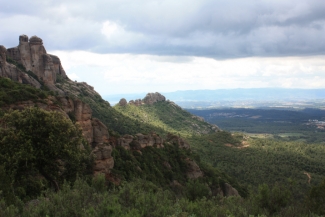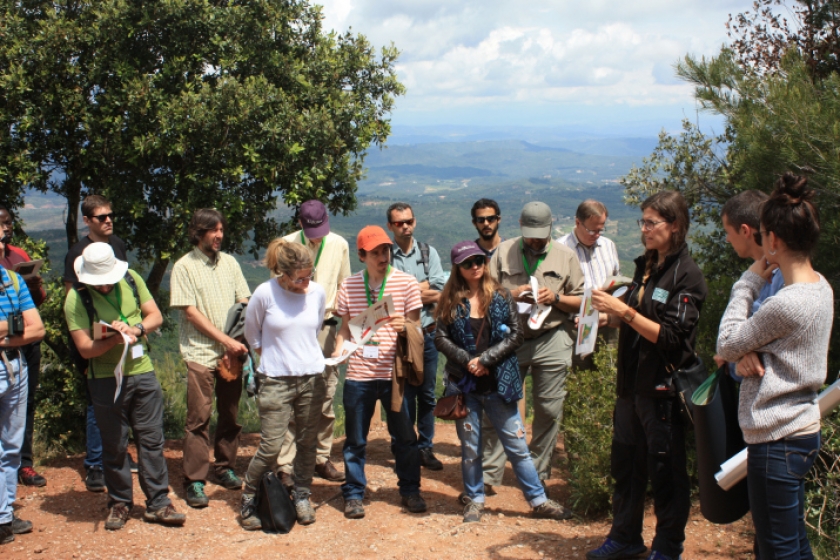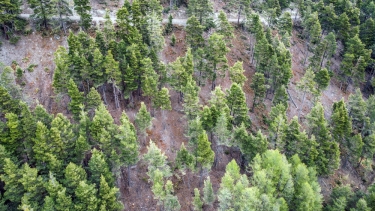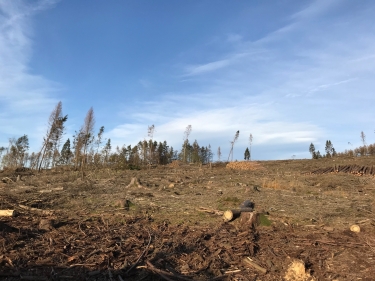Risk management in future forestry

On 6th of June 2018, EFI Bonn’s principal scientist Marcus Lindner and Junior researcher Laura Nikinmaa participated in the conference “COMMUNICATING RISKS IN Decision Support Systems: from basic research to advanced decision support tools” with 30 other researchers in Solsona, Spain. Hosted by the Forest Science Centre of Catalonia (CTFC), the conference was organized by the SuFoRun project and IUFRO’s Risk Analysis working group 4.04.07. The program provided plenty diverse presentations ranging from using real option analysis to deal with uncertainties to effects of bark stripping on wind resistance of Norway spruce.
The opening session by Dr Rasoul Yousefpour, the coordinator of the IUFRO working group, set the stage for the conference and emphasized the need for forest owners and managers to have better understanding on how to incorporate risk and uncertainty into their planning and management as well as the tools to do it. In the first keynote presentation, Prof Jette Jacobsen presented how Real Option Analysis could provide a way for them to do that.
The second session was all about SuFoRun project outcomes. SuFoRun is an exchange project supported by a Marie Skodowska-Curie Research and Innovation Staff Exchange (RISE), which supports analysis and knowledge exchange on multipurpose forests, with a particular focus on risk and uncertainty. Presented project results dealt e.g. with optimizing the regularity of wood supply to the pulp mill under uncertainty, spatial planning under uncertainty, robust biodiversity management and the future fire regimes and how to predict them.
In the second keynote, Dr Pedro Zorilla-Miras addressed the insurance value of ecosystems in case of national hazards. Subsequent presentations shed light on new approaches, which assess the relative risk of pests and diseases in the process of tree species selection, on how landscape diversity can reduce risk of insect outbreaks and on the dynamic modelling of forest development under natural hazards. The message was clear: risk measurement is not risk management. As Susan Davies from University of Edinburgh said: “We need to make decisions now regardless the state of information we have.”
The final session of the first conference day was dedicated to linking science and practice by presenting the SURE and NetRiskWork projects, coordinated by EFI and CTFC, respectively. This included e.g. presentations on the RiskPlatform, an interactive communication tool for the European Forest Risk community which aims to connect practitioners, academia and public stakeholders and to initiate the discussion of risk-related topics and the exchange of best practices. Both presentation also shed light on the importance of forest risk awareness, as well as the development of best practices guidance and regional forest risk networks.
On the second day, the researchers were able to attend a field excursion and to gain deeper insight into wildfire risk in Catalonia. The excursion was led by Eduard Plana from CTFC. At the first stop in the area burned in 1998, he explained the importance of knowing about the socio-ecological activities and history of the region to be able to understand the fire ecology and especially fire management. For example, in the beginning of the 20th century forests were used as a pastoral land and therefore the fuel load was smaller and in consequence the occurring fires were less intensive. Nowadays forests are not often used as pastoral land or in other management schemes, causing the fuel load to accumulate. Thus, the risk of more intensive fires increases. However, the people of the region still often rely on the information of the old fire regimes, which can lead to under-preparedness in fire management.
The second stop was at the iconic mountain of Montserrat, which was threatened by the Òdena wildfire in 2015. A Life+ project had treated part of forest areas to reduce flammable biomass only a few months before the fire. While the measure did not prevent fire damage completely, it enabled the fire fighters to stop the fire from spreading closer towards the monumental rocks of Montserrat. The participants were joined by Núria Prat Guitart from the Pau Costa Foundation, Edgar Nebot from Catalan Fire Service, Leire Miñambres from the Diputació de Barcelona and David from Catalunya-La Pedrera Foundation, who informed the group about the local fire management practices and explained how the recent mega fires had shifted the focus from solely suppressing fires to risk management and prevention practices. The final stop of the day was on the boarder of the Natural Park of Montserrat and urban habitation. The urban interface challenges the fire management in its own way. House owners are not always well informed about the fire risks and how these are influenced by the surrounding environment and its management.
The final day of the conference took place in Barcelona, kicked-off by Prof Marc Hanewinkel’s keynote on “How to handle risk and natural hazards”. He emphasized that the vulnerabilities of both forest and society need to be known in order to understand what the risks are. The rest of the sessions dealt with the economic side of different adaptation strategies, implementing survival probabilities in economic stand valuation and assessing tree health and storm resistance factors. The conference was concluded with insights on different existing decision support tools on forest growth, tree survival, post-fire salvage logging and wind risk management. This rounded up an inspiring conference.



